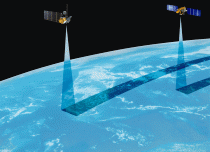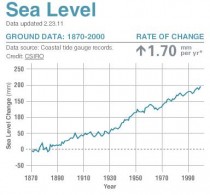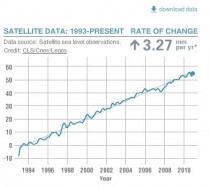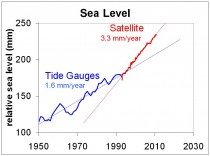Jun 14, 2011
Estimates of Global Food Production in the Year 2050: Will We Produce Enough to Feed the World?
By Craig Idso, CO2 Science
Government leaders and policy makers should take notice of the findings of this important new analysis of the world food situation; for doing what climate alarmists claim is needed to fight global warming will surely consign earth’s human population to a world of woe, while doing next to nothing in terms of altering the current warm phase of the planet’s surface temperature.
A new study by the Center for the Study of Carbon Dioxide and Global Change—Estimates of Global Food Production in the Year 2050: Will We Produce Enough to Adequately Feed the World?—reveals that a very real and devastating food crisis is looming on the horizon, and continuing advancements in agricultural technology and expertise will most likely not be able to bridge the gap between global food supply and global food demand just a few short years from now.
Crop yield and production data were utilized to identify the crops that supply 95% of the food needs of (1) the world, (2) six large regions into which the world may be divided, (3) twenty sub-regions, and (4) the world’s twenty-five most populated countries. Recent productivity trends of these key crops were then projected to the year 2050 for each of the specified geographical areas, revealing that expected advances in agricultural technology and expertise will increase the food production potential of many countries and regions. However, these advances will not increase production fast enough to meet the needs of the planet’s even faster-growing human population. But when the positive impact of Earth’s rising atmospheric CO2 concentration on crop yields was considered, the severity of the pending food shortage was found to be considerably lessened.
“Having evolved at much higher levels of atmospheric CO2 than those of the current geological period, many land plants grow substantially better with more CO2,” says Dr. William Happer, Cyrus Fogg Brackett Professor of Physics at Princeton University, who states that the report “provides a very thorough review of the beneficial role of increased CO2 on mankind’s most important agricultural crops.”
In order to avoid the unpalatable consequences of unprecedented widespread hunger - and even starvation - in the years and decades ahead, the study’s author, Dr. Craig Idso, contends that “a commitment similar to that which drove the Apollo moon-mission is needed to increase crop yields per unit of land area, per amount of nutrients applied, and per amount of water used.” And about the only way of successfully doing so without the taking of unconscionable amounts of land and water from nature and thereby driving untold numbers of plant and animal species to extinction, is to “invest the time, effort and capital that is required to identify, and to then use, the major food crop genotypes that respond most strongly to atmospheric CO2 enrichment.”
However, rising CO2 concentrations are considered by many people to be the primary cause of what is claimed to be unprecedented global warming; and if regulations restricting anthropogenic CO2 emissions are enacted to fight this perceived but likely phantom problem, Idso contends that they will “greatly exacerbate” food shortfalls by reducing the CO2-induced yield enhancements that are needed to supplement the productivity increases provided by expected future advances in agricultural technology and expertise. And in the wake of such emissions regulations, hundreds of millions of people the world over will likely experience significant hunger and malnutrition.
Government leaders and policy makers should take notice of the findings of this important new analysis of the world food situation; for doing what climate alarmists claim is needed to fight global warming will surely consign earth’s human population to a world of woe, while doing next to nothing in terms of altering the current warm phase of the planet’s surface temperature.
The report can be viewed or downloaded at the website of the Center for the Study of Carbon Dioxide and Global Change. Questions about the report can be addressed to Dr. Craig Idso at the email address contactus@co2science.org.
Jun 12, 2011
Crater Lake USHCN weather station - the GISS removal
By Anthony Watts
Readers may recall I wrote in this article about my family memorial day excursion to Crater Lake:
Crater Lake happens to have a USHCN weather station, and it is one of the few stations that GISS excludes (they have an exclusion code for it in their software Mosher located some time ago).
Steve Mosher commented in detail about that:
--------
Thanks for remembering that Anthony.
In addition to crater Lake there were 4 other northern California stations that GISS had removed from the data. In the paper Hansen merely says this:
The strong cooling that exists in the unlit station data in the northern California region is not found in either the periurban or urban stations either with or without any of the adjustments. Ocean temperature data for the same period, illustrated below, has strong warming along the entire West Coast of the United States. This suggests the possibility of a flaw in the unlit station data for that small region. After examination of all of the stations in this region, five of the USHCN station records were altered in the GISS analysis because of inhomogeneities with neighboring stations (data prior to 1927 for Lake Spaulding, data prior to 1929 for Orleans, data prior to 1911 for Electra Ph, data prior of 1906 for Willows 6W, and all data for Crater Lake NPS HQ were omitted), so these apparent data flaws would not be transmitted to adjusted periurban and urban stations. If these adjustments were not made, the 100-year temperature change in the United States would be reduced by 0.01C
Well, I wanted to see the analysis, the code, that was used to make this determination that these stations were flawed. Gavin basically said the paper documented everything, but these words don’t tell me HOW it was done. It just says THAT it was done. Any way that was pretty much why I wanted the code released. When it finally was released, you will see that there is no analysis supporting the removal of these stations. Upon inspection you can see some flakey stuff with the stations, but I was looking for math that quantified the flakiness. In the end, these were excluded by hand.
The argument of course is that including them or excluding them amounts to a tiny difference. That argument never held much water for me. The question, in my mind, was how many other flakey stations were there and was there math that could detect it? I think that’s a good question. It doesn’t make me doubt the record, I just think its a good question.
------
I agree. I don’t know that Crater Lake data is flawed or “flakey”, it just may reflect the snow pack hanging around longer, creating a cool bias into summer. With the snow pack as heavy as it is this year, it will be interesting to see if that has an effect of suppressing mean temperature.
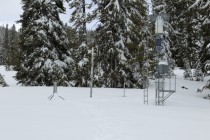
Jun 09, 2011
Death Threats And Tattoos: Climate Frenzy Update
By Dr. William Briggs
Concentration Camps To Re-educate Deniers Next?
It’s time to make public examples of those that disagree with reporter, and non-science-educated Richard Glover’s view of climate change. He would have skeptics “forcibly tattooed on their bodies.” Says the man, whom I’m willing to bet would not be able to explain a Lagrangian to save his life,
Not necessarily on the forehead; I’m a reasonable man. Just something along their arm or across their chest so their grandchildren could say, “Really? You were one of the ones who tried to stop the world doing something? And why exactly was that, granddad?”
Glover never says what form this cattle brand should take. Yellow and pink stars having already had their day, and the Mark of the Beast yet to come, I suggest a likeness of Alfred Wegener, a man who stood against the - strike that: the - consensus of his day, only to see his views vindicated in time.
Our would-be Australian comic Glover admits that “maybe the tattooing along the arm is a bit Nazi-creepy.” Only a “bit”, my dear?
As an alternative to imitating the Gestapo, he next suggests forcing his opponents “to buy property on low-lying islands”. He has the idea that this land “will become worthless with a few more centimetres of ocean rise”. As a duly elected officer of the Climate Skeptics Conspiracy, I accept this suggestion as binding, with just two provisos. The first is that our bids face no competition from other land speculators. Fair’s fair, after all.
To own a hunk of Hawaii - oceanfront Hawaii! A fraction of Fiji! Tracts of Tahitian Beaches! Imagine the views from the Virgins! White sands, palm trees, rum by the gallon! All at rock bottom prices, practically given away to those who refuse to heed the Chicken Littles of their day. You have yourself a deal, Glover, old man.
As long as you accept proviso two, designed to make the bet equitable. Writing in the June, 2011 New Criterion, Joseph Tartakovsky reviews the life of James Wilson, one of America’s founding fathers. Wilson, said, Tarakovsky
“mocks timidity about new legislation by recalling that the Locrians required a citizen who wished to propose a law to appear before the assembly with a cord around his neck and explain his reasons; if they were found wanting, he was promptly hanged.
We’ll buy the land, but you and your nervous brethren must immediately slip nooses around your necks so that if, say, in five years our beaches still exist, we can hang you from the nearest Bunya Bunya tree. I suggest1 that it would be unmanly - that is to say, womanly - of you to cavil with this bet.
Death Threats For Climate Scientists
Some Australian climate scientists have received death threats, over which Boing Boing inaptly calls “social media.”
These scientists are not enjoying threats because of their scientific activities, but because of their political activism. Seems a good many researchers are agitating for a new “carbon tax” to battle something called “carbon pollution.” It’s not clear what this is, but it must be euphemistic because of course carbon is the exact opposite of a pollutant.
But let’s not lose focus. Threats of death! Do meek men in lab coats who sport ill-considered facial hair and who sincerely believe they are “saving” their planet deserve to be told, “Shut up or die”? They do not.
I have investigated the matter and can say with certitude that the Climate Skeptic Conspiracy is not responsible for issuing intimidations via Twitter, Facebook, or any other media. We do not take in half-wits as members, and it is from this appalling group the threats originate.
I admit to jealousy: I have never received a death threat. That is to say, not since my days as a military man, where I heard with some regularity variants of the phrase, “Briggs, you ---. I’m gonna kill you!” And there was the incident where a sheriff, with whose son I had a tussle back in high school, drug me into his car and pointed his pistol at my nose and asked politely to distance myself from his spawn.
I suppose I should count the time, just last week, when a guy tried to muscle his car past me on 59th street, where I was crossing on foot. We exchanged words, but traffic forced him to drive on. Which he did, but only around the block, where he found me on 60th, and where we expressed views that most courts of law would interpret as threats of a mortal nature.
It is better said that I never received death threats for my political views. I am still hopeful.
Jun 05, 2011
Climate alarm not justified, say experts at Ottawa Conference
By Tom Harris
Anyone not already familiar with the stance of geologists towards the climate scare would have been shocked by last week’s conference at the University of Ottawa. In contrast to most environmental science meetings, climate skepticism was the norm among the thousand geoscientists from Canada, the United States and other countries who took part in GAC-MAC 2011 (the Joint Annual Meeting of the Geological Association of Canada, the Mineralogical Association of Canada, the Society of Economic Geologists and the Society for Geology Applied to Mineral Deposits).
The lead symposium of the conference, “Earth climate: past, present, future”, was especially revealing. Chaired by University of Toronto geology professor Dr. Andrew Miall, the session description starts: “The scientific debate about climate change is far from over. Some of the projections of climate change and its consequences contained in the 2007 Report of the Intergovernmental Panel on Climate Change (IPCC) have been called into question. This symposium will address some of these issues and present a geological perspective on the scientific debate.”
Talk after talk at GAC-MAC were from “climate rationalists”, defined by Australian geology Professor Bob Carter of James Cook University as “persons who are critical (on balanced scientific grounds) of the IPCC’s alarmism, ...reflecting the primacy that such persons give to empirical data and thinking. The climate rationalist approach contrasts markedly with the untestable worlds of computer virtual reality that so many climate alarmists now inhabit.”
Leading off the GAC-MAC climate symposium was fellow Australian, Dr. Ian Plimer, Professor in the School of Civil, Environmental and Mining Engineering at the University of Adelaide. In a keynote presentation entitled “Human-induced climate change: Why I am skeptical”, Plimer completely dismantled the greenhouse gas-driven climate change hypothesis. He showed how climate has varied naturally on all time scales and how recent changes are not unusual. Plimer explained the lack of meaningful correlation between the greenhouse gas carbon dioxide (CO2) and planetary warming and cooling and how “climate models throw no new light on climate processes.” He concluded, “Pollution kills, CO2 is plant food, H2O vapour is the main greenhouse gas.... Humans can adapt to future changes.”
Following Plimer were 14 other climate presentations by leading geoscientists. Dr. Henrik Svensmark of the National Space Institute of the Danish Technical University spoke about how cosmic ray variations in the atmosphere are influencing climate by changing the microphysics of clouds. University of Ottawa emeritus professor Ján Veizer presented his research describing the role of the sun and water vapour on CO2 and climate change. Calgary geologist Norm Kalmanovitch detailed his findings that human-caused global warming theories are not supported by observational data. Carleton University researcher Dr. Hafida El Bilali showed how her work with paleoclimatologist Professor Tim Patterson revealed that variations in the output of the sun have had a major influence on regional climate for the past nine millennia.
And so it continued. Not a single presentation in the symposium supported the IPCC’s human-caused dangerous global warming hypothesis. In the discussion period following the talks, climate rationalists decried the lack of media or public attention to the symposium or their research findings. In the exhibit hall, few exhibiters seemed interested in human-caused global warming and the catastrophic messages that so overwhelm delegates at other climate-related conferences were nowhere to be found.
Where were the scientist supporters of climate alarmism? Did they not know that climate was a major focus of this, the largest geologic conference in the country?
They knew. According to Miall, even though some were directly invited, they either refused to participate or ignored the invitation. “The people on the IPCC side will not debate,” explained Miall. “Anything that’s brought up that they disagree with they say has been dealt with and is no longer considered important or is a minor effect. This is often quite wrong.”
In front of the public lecture at last June’s Canadian Meteorological and Ocean Society (CMOS)/Canadian Geophysical Union (CGU) Congress in Ottawa, the prospect of a public debate between the two sides was put to keynote speaker Dr. Warwick Vincent of Laval University. Vincent was supportive, as was a CMOS past president. Yet, on later approaching CMOS executives and directors about taking the steps necessary to arrange such a public dialog, the responses were negative to the point of abuse and nothing transpired.
Suggestions of a proper climate science debate have been ignored by CMOS for many years. For example, in the December 1997 CMOS Bulletin long-time CMOS member Dr. Madhav Khandekar, then just retired from his Research Scientist position at Environment Canada, pushed for an open dialog in his article “Global warming & climate change in Canada: A need for an open scientific debate” CMOS executives completely ignored the piece.
In 1990, Dr. Tad Murty, then Senior Research Scientist in DFO’s Institute of Ocean Sciences and chairman of the scientific committee for that year’s CMOS congress, tried to arrange it so that two of the four invited speakers were climate rationalists. However, the other nine scientists on the scientific committee vetoed the idea and it died.
Going into next week’s congress in Victoria, CMOS, like many organizations of its ilk, maintains a rigid stance of climate catastrophilia. The congress includes sessions described with clearly mistaken statements such as “Recent research has highlighted the irreversibility of CO2-induced climate change on centennial timescales ....” Other, less extreme but also unjustified assertions abound: “It has become widely recognized that under a changing climate, the frequency and intensity of meteorological/hydrological extreme events and associated damage costs would more likely increase in the 21st century.”
The narrow-mindedness of CMOS and other climate alarmists matters because they have the ear of mass media, most of whom uncritically report on CMOS’ public statements that the science is settled and debate unnecessary. As a consequence, the public are highly influenced and seriously flawed CMOS messages are incorporated into government pronouncements and actions.
Miall maintains that the views of geoscientists are crucial for a proper understanding of climate. Consequently, uncomfortable though it may be for these experts, society needs them to speak out forcefully. Otherwise, the climate alarm, its science failing but the movement still powerful, will stagger on, leading society to waste billions of dollars and destroy thousands of jobs. It is time to put the climate change zombie out of its misery.
|




